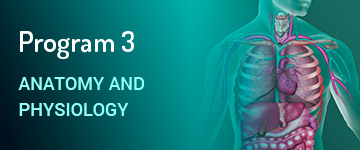UMORE - Pharmacy
Program 3
Program 3: Human Anatomy and Physiology

This Program introduces foundational biological principles of medical terminology, biochemistry, cells, body systems and immune response. The program delivers interactively presented information about all systems of the body with incorporation of real-life applications and practical examples.
Program 3 is comprised of 14 modules and is estimated to take approximately 28 hours to complete.
Intended Learning Outcomes
- Distinguish the scientific language of anatomy and physiology
- Explain fundamental biochemistry principles
- Describe cell structure and function
- Develop anatomical and physiological knowledge and understanding of the systems of the body – skeletal, muscular, nervous, endocrine, reproductive, urinary, digestive, respiratory, cardiovascular, integumentary, lymphatic and immune
- Analyse and interpret the effects disease may have on body systems
- Apply the concept of homeostasis to body systems
- Describe the body’s basic defence mechanisms against disease
- Apply understanding of anatomy and physiology to the evaluation of real-life scenarios and data analysis
Module contents
This module introduces chemical and physiochemical concepts related to the human body. We take a look at the periodic table and how atoms chemically combine to form two types of compounds: molecular and ionic. Through examples and naming of compounds, we investigate the chemical and physical properties of the compound types. Water is a major component of the human body; we examine how different compounds interact with water. Some compounds do not dissolve in water, others dissolve to form electrolytes, and yet others are acidic or alkaline (basic) in the human body.
Module 3C: Cells introduces the similarities and differences in cell structure among various organisms. We identify the basic functions of organelles common to animal cells and look closely at the movement of substances across the cell membrane. We investigate how surface area and volume can affect movement of substances in and out of a cell and place limitations on the size of cells and organisms. We look into the means by which our cells replicate to ensure our development, maintenance and growth. A human starts life as a fertilised egg; we describe the formation of the sex cells, which fuse to create human life.
The skeletal system introduces the purpose of the human skeleton in terms of support and protection. The structure of the skeletal system, its components and subdivisions are examined before looking in detail at the anatomical and physiological characteristics of bones and joints.
The muscular system introduces the purpose and functions of muscles in the human body. We investigate the anatomy and physiology of the different types of muscle and the biomechanics behind movement.
This system consists of the heart and the network of vessels that carry blood. It delivers oxygen and nutrients to the body’s cells, and carries away their waste products. Blood also transports substances such as hormones and immune cells. The lymphatic system plays a critical role, helping to return fluids to the cardiovascular system, and fighting infection.
Working in close conjunction with the nervous system, the endocrine system provides communication directed by chemical messengers called hormones. These chemicals are released by the glands of the endocrine system, and circulate through the body in the bloodstream and other fluids.
This system consists of the heart and the network of vessels that carry blood. It delivers oxygen and nutrients to the body’s cells, and carries away their waste products. Blood also transports substances such as hormones and immune cells. The lymphatic system plays a critical role, helping to return fluids to the cardiovascular system, and fighting infection.
The respiratory system is centred on the lungs, which are the site of gas exchange between the environment and our bloodstream.
With the assistance of our muscular system, air is drawn into the lungs to obtain oxygen, and carbon dioxide is expelled.
The digestive tract is a single canal that begins at the mouth and ends at the anus. Along the way, it digests food mechanically and chemically, allowing nutrients from the broken down food to be absorbed into the bloodstream.
The digestive system also eliminates waste from the body.
The body’s cells produce waste products, many of which are transported via the bloodstream to the kidneys for filtration and elimination in urine. The urinary system ensures the correct balance of fluids, salts and minerals.
The reproductive system allows humans to produce offspring. Reaching adult maturity is governed by hormones of the endocrine system. Male and female reproductive systems differ significantly, both anatomically and physiologically.
Skin, hair and nails (our integument) help to protect the body’s internal tissue from damage; provide a barrier to reflect radiation; and prevent invasion of pathogens. The layer of fat under our skin insulates and protects. It helps to regulate body temperature and excrete waste through sweating.
The immune system is comprised of a range of specialised cells and proteins which protect our body against foreign objects, pathogens and malfunctioning internal processes. In order to provide physical, chemical and cellular responses, the immune system is highly integrated with other systems, including the lymphatic system, integumentary and skeletal systems.
For more information on this or other UMORE courses, and to enrol, sign up to our iLearn website.
